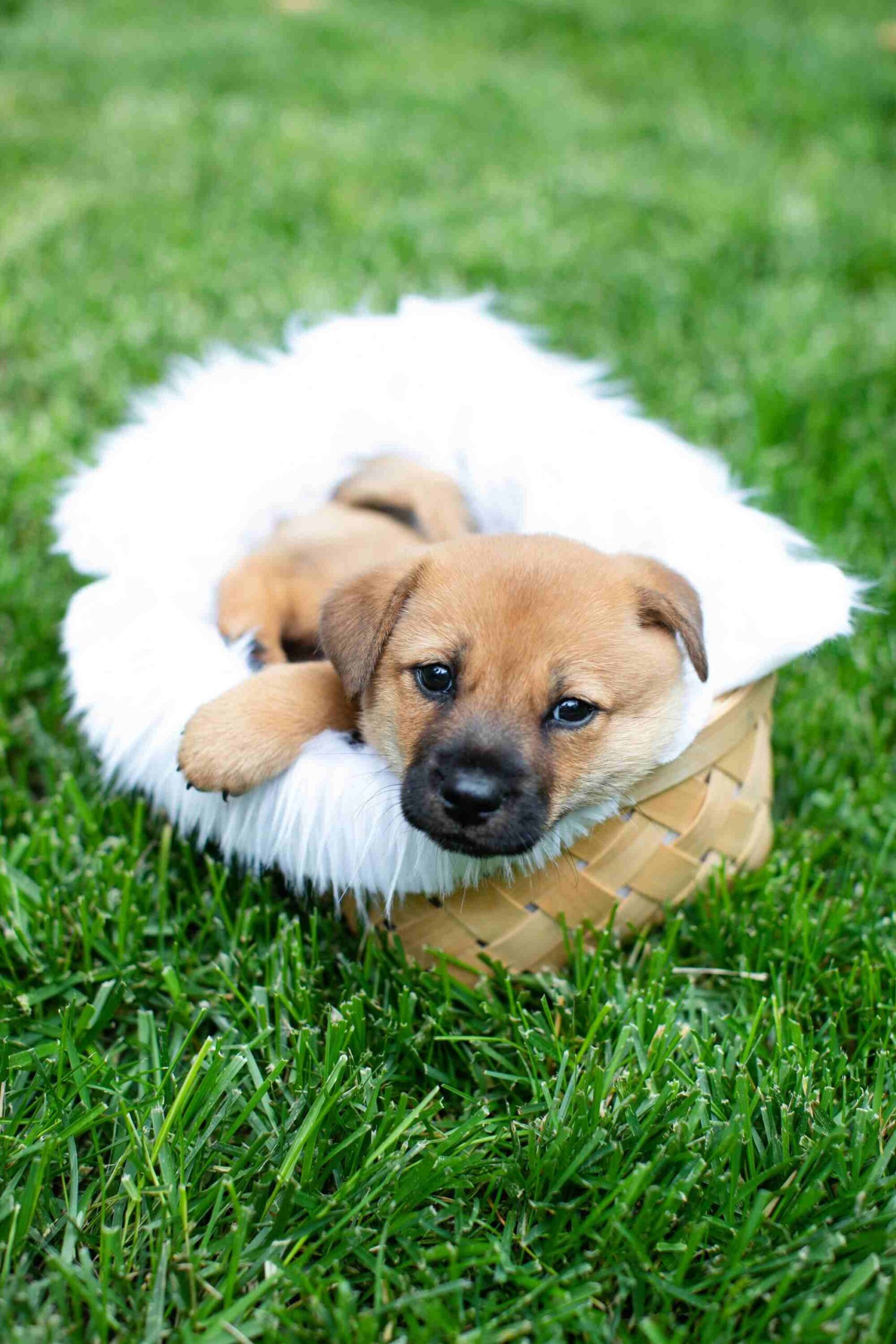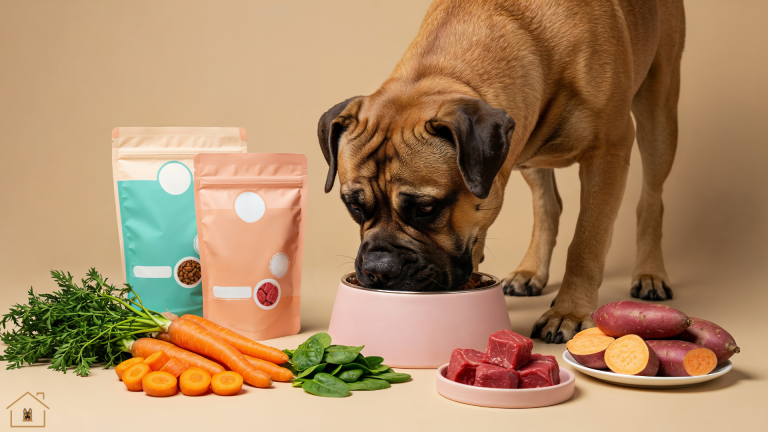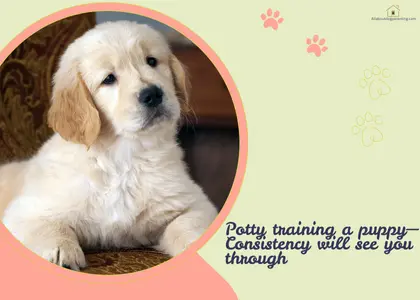What to Expect When Bringing a Puppy Home
Bringing a puppy home is equal parts thrilling and overwhelming. You’ll be watching every twitch and yawn, trying not to blink in case you miss something adorable. But you’ll also find yourself on high alert for the next accident or puppy meltdown. As a pet parent who has watched four little fur balls grow into healthy dogs, I’ve been there more times than I care to admit. While it can seem excessive to someone on the outside, say your friends or family who don’t have pets, let me tell you, this mix of excitement, nervousness, and exhaustion is completely normal.
That said, it’s possible to manage these emotions well so you can focus on your new puppy’s well-being rather than being overwhelmed yourself. The key to that, I’ve found, is being prepared for whatever your pet parent journey may throw at you.
In this guide, I walk you through preparing for bringing home a new puppy, what really happens those first few days and weeks, and how to handle training, health needs, emotions, and pitfalls. Think of this as everything I wish I’d known before our first puppy arrived, from puppy-proofing to puppy blues, so you and your new family member can hit the ground running.
Preparing for Your Puppy’s Arrival
Before your puppy even steps paws in your door, take some time to get everything ready. Picture your home through curious puppy eyes: down low there are power cords, tasty shoes, indoor plants, and cleaning supplies, all of which can be harmful to your furry baby and need to be kept out of their reach. So, one of the most important things on your checklist before bringing your puppy home is gathering puppy-proofing essentials and installing them correctly. This entails:
- Tucking away wires and cables
- Locking trash cans and cabinets
- Removing choking hazards or small toys
As the AKC advises, “Protect your dog and your home from potential trouble spots”, with a puppy-proofing checklist. Do a room-by-room sweep and,
- Secure trash bins
- Move houseplants out of reach
- Put medications and chemicals up high
- Cover electrical outlets
Baby gates are another lifesaver: block off stairs or whole rooms so your puppy can explore safely without getting lost or into trouble. Keep in mind this is temporary; pick gates you can easily remove when they’re older.
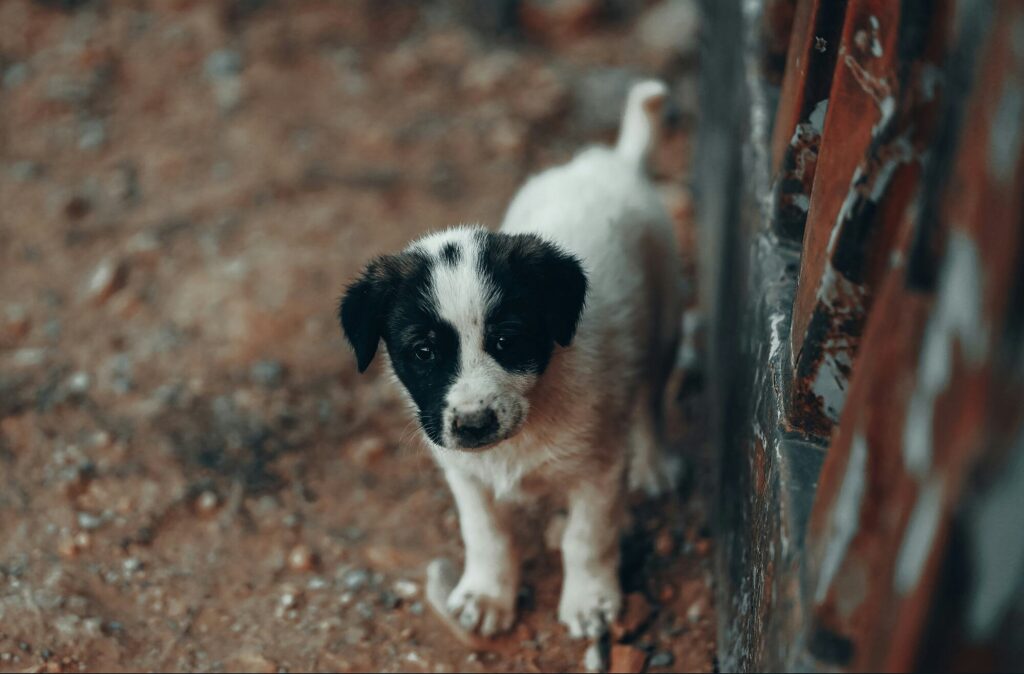
Next, you need to gather all the supplies you’ll need, such as:
- Crates for a new puppy: I recall one of my first purchases was a sturdy crate, a cozy den for naps and nights. Make sure it’s big enough for the puppy to stand up and turn around, but not so huge that they can use one corner as a bathroom
- Best dog beds for puppies: You’ll also want a soft bed or blanket inside the crate to make it inviting
- Puppy starter kits: This includes food and water bowls. In my experience, stainless steel or heavy ceramic works best. Don’t forget a collar and leash, even very young puppies will start getting used to wearing a collar around the house
- Puppy training pads: These are a lifesaver in your potty training your puppy as well as keeping your home clean, sanitary, and odor-free until your pet develops a bathroom schedule. House-training mishaps are inevitable, stock up on cleaning supplies—paper towels, enzyme cleaner, and stain removers
- High-quality puppy food: This is among the most crucial items on your new puppy checklist. It helps to stick with whatever food your breeder or shelter was using for the first few days, then transition slowly to a new diet as your vet recommends. Have plenty of healthy training treats on hand, which will be invaluable once you start teaching commands
- Grooming basics: Gather the grooming basics now too. You’ll need a gentle brush or comb suited to your puppy’s coat length, puppy shampoo, for occasional baths, nail clippers, and even a soft toothbrush.
- Toys: Toys are vital as well. Durable rubber toys and ropes can save your furniture by giving your teething puppy something appropriate to chew. Soft-stuffed toys and tennis balls are fine, as long as you keep an eye on your puppy, to prevent choking on tears or pieces
Finally, set some house rules before the puppy arrives. Ponder over questions like:
- Will the puppy be allowed on the couch or in your bed?
- Where should they sleep at night?
- Can they take food from your plate?
Make decisions about these as a family, and then, make sure that each member treats these laid down rules as non-negotiable. Only then will your puppy learn what is acceptable behavior and what’s not. If the rules keep changing or different people in the house enforce different rules, your puppy will get confused.
Consistency in boundaries and enforcing the rules you want your pet to follow is one of the most crucial new puppy owner tips for raising a well-behaved canine companion. I cannot stress this enough. Dogs are creatures of habit, and if you don’t work on helping them form good habits right from the moment your puppy comes home, there are going to be issues to deal with down the line.
Suggested Reading: Puppy Chewing on Paws? Causes and Remedies
First Day and Night Home: What Really Happens
The first 24 hours with your puppy will be a roller coaster, for you as much as for them. Expect big emotions, endless yawns, and a few accidents. When you finally arrive with your squirmy new pup, go slow. In my experience, and based on expert recommendations, the first order of business when you bring your puppy home should be taking them directly outside to the area where you want them to eliminate. Let them sniff the yard and praise them if they go potty. It might seem silly to haul a crate-load of fluff outside on day one, but even one successful potty outside is a huge victory.
Introductions
Once inside, give your puppy a tour of one room at a time, and not the whole house at once. This is also when any members of the family who weren’t part of the “bring your puppy home” party will meet the little furball. Keep introductions limited and calm. Limiting your pup’s interactions and exposure to new spaces prevents them from feeling overwhelmed. Also, take them to their new sleeping spot (a crate or bed, whichever you choose) and the spot where their food and water bowls are.
Comfort
Then, give your puppy some alone time to wind down. The car ride home and the whirlwind of activity that followed likely has them beat. This will give them a chance to rest and recoup. However, along time doesn’t mean leaving your puppy unsupervised. Keep them under your watch but do not actively engage with them.
If possible, bring home a few comfort items like a a blanket or toy that smells like the puppy’s litter or mother. This familiar scent can really help the puppy settle in. For example, my breeder gave us a soft towel her puppies had cuddled on. That first night, having something that smelled familiar made a big difference. That soft towel remained a part of his bed for the first year of his life and we discarded it only when he stopped showing any interest in it.
Suggested Reading: How Do Dogs Communicate — With Each Other and With You
Accidents
Don’t be surprised if things get messy and noisy. In fact, expect accidents and be prepared to deal with them. Puppies can’t hold it long, especially after travel, so chances are they will pee or even poop inside the house a few times during the first few days or even a couple of weeks—really depends on your approach to potty training and how well your puppy responds to it. When an accident happens, don’t yell or rub their nose in it. Just clean it up calmly and remember it’s part of the process. If you catch them in the act, hustle them outside immediately. This will help reinforce where you want them to go.
Feeding
For feeding your puppy, it’s best to follow the schedule and the diet they’ve been on, for the first couple of days. You can, then, work on setting a puppy feeding schedule that aligns best with your lifestyle and your puppy’s needs, either by researching about the topic or consulting your vet.
Usually young pups eat 3-4 times a day in their first few weeks. You can tweak these timings based on convenience but make sure that the frequency of meals is kept consistent. Also, always supervise meal times and make them positive. Feed and praise calmly so your puppy feels safe eating in a new place.
Napping
Your puppy will likely spend a lot of their first day and night in their new home napping. Puppies sleep 16-18 hours a day on average. When it’s time to sleep, put the puppy in their crate. Do put the crate in your bedroom for that first night. Not only will it give you peace of mind, having you near, makes the pup feel secure having you.
You must also make sure that your puppy sees their crate as a safe space and not a punishment. Make it a cozy den for them by adding that scented blanket or toy and maybe a soft night light. This will make crate training easy, and go a long way in preventing separation anxiety in your dog.
Whining is inevitable
Expect some whining. Many puppies cry on night one—and maybe night two or three—as they get used to being alone. If your puppy whines or howls, resist the urge to immediately scoop them into bed. This teaches them to cry for attention. Instead, be patient and comforting from a distance. Some owners gently place a hand on the crate or speak softly.
If a potty break is needed, often before midnight and/or early morning for very young pups, open the crate quietly, scoop them up, take them out to potty on leash, and then put them right back without too much fuss. Eventually, your puppy will accept their crate as a safe space and learn to settle down for the night.
Suggested Reading: Do Dogs have Emotions?
First Week: Routine Building
The first week is all about building a routine that your puppy can count on. Dogs, like toddlers, do best when they know what to expect each day. Board-certified veterinary behaviorist Dr. Karen Overall, MA, VMD, PhD, DACVB, says, “Structure will help your new puppy feel secure and know what’s expected of him. The best way to do this is to create a schedule and stick to it.” This includes:
Feeding schedule
Continue feeding your puppy 3–4 small meals a day on a regular timetable. For example, breakfast, lunch, and dinner. Note exactly what and how much you feed each time, and stick to it. Apart from regulating digestion and poop schedule, this contributes to the consistency we’ve been talking about. Always have fresh water available. Drain and refill the bowl regularly so it stays clean.
Potty training
Housebreaking is the #1 task in the first week. Take your puppy out to their potty spot frequently: after they eat, drink, wake up from any nap, and after play sessions. In addition to that, once every 2 hours in the beginning, and then gradually increase the gap.
When your puppy eliminates outside, praise them enthusiastically and give a treat immediately. This positive reinforcement teaches them that “going potty here” is wonderful. If there’s an accident indoors (and there will be!), clean it up without making a fuss. Do not punish the puppy. At the most, you can say a firm, “No!”, if you catch them in the act, and then carry them outside to the designated spot. But if the deed is already done, yelling or rubbing your pet’s nose in it, won’t solve anything.
Suggested Reading: How to Crate Train a Dog with Separation Anxiety: 7 Simple Steps
Crate training
Keep using the crate for naps and bedtime. Early on, feed a meal or give treats inside the crate to build good associations. When your puppy starts voluntarily entering the crate, close the door for a minute or two, then open it before they finish so they learn it’s okay. Gradually increase the closed-door time.
The UC Davis Vet School notes, “Dogs have a denning instinct and instinctively do not like to soil in their dens and will go outside to eliminate.” Crate training works by tapping into that instinct, slowly teaching your pup that the whole house is their den and the bathroom is outside.
Pro Tip: If your puppy cries in the crate, do not yank them out as a reward. Wait until they’re quiet before letting them out. This teaches them that silence wins rewards. In my experience, having short crate sessions throughout the day, even when you’re home, helps them nap and learn calm behavior.
Leash and collar
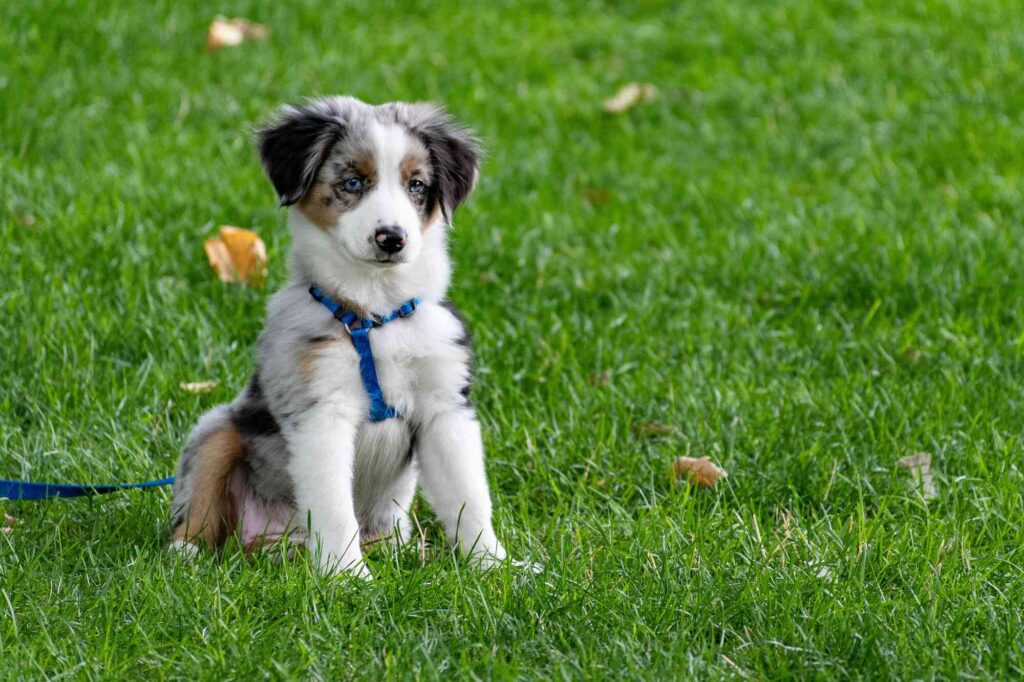
Use this week to get your puppy used to wearing a collar and leash indoors. Let them wear a lightweight collar and leash while you’re nearby. Throw some treats on the ground and guide them with the leash. Soon switch to brief walks in a quiet area, like your fenced yard, on a leash. The key is making leash time fun.
Dog trainer Kathy Santo suggests starting by rewarding the puppy for even just looking at you on leash. Use a clicker or a cue word, coupled with treats, as soon as their attention comes to you. You can even play a game of “chase the treat” while holding the leash so the puppy moves with you. Remember, they have short attention spans: keep sessions 5–10 minutes and upbeat.
Name recognition and basic cues
This is also a great time to teach your puppy their name. And then, add the “come” command to it. In a quiet room, say their name or “come” in a happy voice and immediately reward them with a treat when they look at you. You don’t need a formal sit-stay-come routine just yet. Just tossing a treat on the floor and calling their name when they finish can do wonders for recall. If they don’t respond to their name yet, move closer and try again. Don’t repeat the cue endlessly or they’ll start ignoring it.
Bite inhibition
Teething puppies love to nip. It’s how they explore and soothe sore gums. This cute aggression can quickly turn into the bane of your existence if not discouraged and corrected right from the get go. While it may be fun to let a little 8-week-old puppy with pin teeth nibble on your arm, it won’t be the same, when that puppy is 12 or 16 weeks, with a stronger bite and unabated urge and habit to bite and chew on anything that comes their way.
To prevent blue bruises on your arms and legs, and bite marks on your furniture and shoes, teach bite inhibition from the very first week. Dr Overall says that puppies naturally learn not to bite hard from their littermates, who would yelp “Hey, that hurt!” when bitten too roughly. You can mimic this.
If your puppy nips you during play, make a sharp high-pitched, “Ow!” sound and then stop playing for a moment. If “ow!” makes your puppy more excited, try calmly turning away or putting them in their crate for a minute to calm down. When play resumes, offer a chew toy any time their mouth goes near your hand or sleeve. Teaching them early what is okay to chew (toy) and what isn’t (you, the sofa, houseplants) will pay off.
Suggested Reading: Can Resource Guarding in Dogs Be Cured? Yes, It’s Possible!
Socialization
You can begin gentle socialization in the first week after bringing a puppy home. It’s still very early, so skip dog parks or busy places until basic vaccinations have been completed. Instead, let your puppy meet one calm, vaccinated adult dog, if you know one, in a neutral area, on leash and supervised. Watch their body language and separate if either dog gets uneasy.
Introducing kids should also be calm and one at a time. Hold the puppy on your lap or at low height and let a single child pet under supervision. Think of new experiences: maybe bring a leash to an easygoing pet store visit, or have a friend’s quiet dog sniff your puppy outside. The goal is positive exposure to new things—sights, sounds, surfaces. The more your puppy gets to safely explore different carpet, tile, grass, stairs, people’s hats or umbrellas, the more confident and less reactive as an adult they’ll become.
Health and Vet Visits
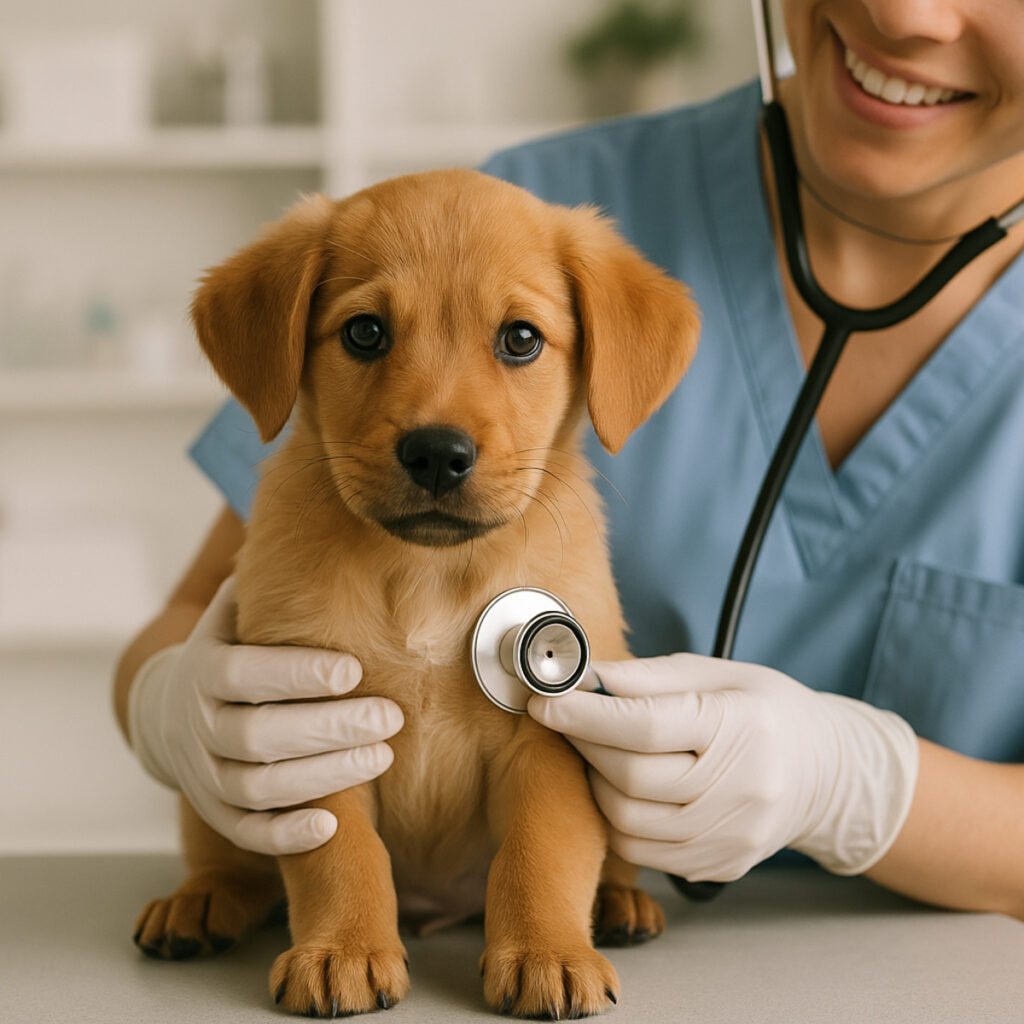
When bringing home a new puppy, you also need to have a health care plan in place. Plan a visit to the veterinarian within a few days of bringing your puppy home. This isn’t just for vaccination but also for a full wellness check. It’s also a crucial step in setting the foundation of a vet-client-patient relationship. Think of it like that first trip to the pediatrician. Here are some new puppy owner tips to keep in mind vis-a-vis their healthcare and vet visits:
First exam
During that first vet visit, the doctor will do a nose-to-tail check. Expect your puppy to be weighed and have their heart and lungs listened to with a stethoscope. The vet will check eyes, ears, nose, and teeth, and feel your puppy’s abdomen and lymph nodes. They may even take their temperature (this is done rectally in animals), and examine your pup’s coat and skin for any fleas or skin issues.
At the end of the exam, you’ll likely set up the vaccine schedule and parasite prevention. The first visit to the vet is a good opportunity to ask any questions you may have about your pet’s behavior and health, ranging from appetite to sleep schedule, food and feeding schedule, tummy troubles and biting tendencies. It helps to make a note of these beforehand, and sit with the vet after they are done with their exam to have your queries answered.
Vaccines
Most puppies start their core vaccines like the distemper/parvo combo, DHPP at around 6-8 weeks of age, then boosters every 3-4 weeks until at least 16 weeks. Rabies shot is usually administered by 12-16 weeks. Your vet will tailor the exact schedule for your area and puppy. Get a vaccination schedule from your vet on the first visit and mark down the dates so you don’t miss any crucial vaccinations.
Suggested Reading: 12 Signs Your Dog Loves You
Parasite prevention
Almost every puppy needs deworming. Typically puppies are dewormed at 2, 4, 6, and 8 weeks, then monthly until 6 months. This is because mom can pass roundworms and hookworms to her pups. If you’re bringing a puppy home at 8 weeks, they will likely have gone through the basic deworming already, and you’ll need to administer doses monthly. If the puppy is even younger—although not recommended, there may be situations where you may find yourself caring for a puppy right from birth; if say, the pups are born to your pet or the puppy you’re bringing home was abandoned/orphaned at birth)—be ready for multiple deworming doses.
The vet may also start an ongoing flea/tick preventative. Many spot-on or chewable treatments are now safe for pups at 6-8 weeks old. For example, the Seresto flea/tick collar is approved for use on puppies as young as 7 weeks and protects for 8 months, but it’s best to double-check your pup’s weight and age before starting any product.
Heartworm prevention
In areas where heartworm, a deadly mosquito-borne parasite, is a risk, you’ll begin prevention early too. The American Heartworm Society recommends starting a heartworm preventive by 8 weeks of age. So, if you’re bringing a puppy home at 8 weeks, this is something to discuss with your vet on the very first visit. These medicines are prescription-only, so your vet will likely sign you up for a monthly chew or topical. Give it year-round and consider annual testing after 6 months old.
Follow-up schedule
Before leaving the clinic, your vet should give you a clear schedule for follow-up visits and vaccinations. That includes booking that second and third puppy shot visit, noting when to repeat worming, and planning the date for spay/neuter. Also, this is a great time to microchip your pup if it isn’t already done. Microchipping is quick and permanent; having that done with the first vet visit means you’ll always have a way to get your dog back if they ever slip away.
Between now and the next shot, monitor your puppy closely. It’s normal to have a tiny sore spot or slight behavioral change for a day after vaccines, but call your vet if you see swelling, hives, lethargy, or vomiting. Outside of scheduled visits, learn the warning signs of serious problems. These include:
- Vomiting and diarrhea together
- Refusing food
- Sudden lethargy
- Pain
- Abnormal drinking
- Eye or ear problems
- Limping
- Drastic mood changes
Early Training and Socialization
Now that your puppy is all settled in begging the fun and effort-intensive word of molding your puppy into the dog you want them to grow up to be. This exercise entails more than just teaching your dog fun tricks. The core objective here is to set the foundation for a happy, well-behaved, well-adjusted pet that can become a family member. Here are the key things to focus on.
Housebreaking
Oh yes, this is an ongoing process and you will have to stick to it consistently. In my experience, when you start potty training a puppy right from the moment they come into your house, they start signalling when they need to go out in a matter of a week. However, given their ability to hold their bladder and bowel movements is still developing, accidents are bound to happen, especially if you don’t adhere to the schedule religiously. Even a two-minute delay in taking your pup out immediately after they’ve eaten or woken from a nap, for example, means a sureshot accident in the house.
Apart from adhering to a potty training schedule, you must also take your pup outside on leash at the sight of any potty cue—sniffing, circling, whining. Clean any indoor accidents with an enzymatic cleaner to remove the scent or your dog will keep going there.
Suggested Reading: Dog Training Toolkit: 18 Essentials
Crate and Bedtime
By now your puppy knows the crate is their den. Keep using it as a safe space for sleeping and calm-downs. I always tuck a small stuffed toy or unwashed blanket in it and maybe cover the crate with a light cloth to make it cozy and dark at bedtime. Over time, your pup will start snoozing there easily. If they cry, give them a minute, but if it goes on, calmly take them out for a pee break—no play, just potty and back in. This consistency helps them learn overnight bladder control a bit at a time.
Basic Obedience Cues
Start simple. The first focus area has to be name recognition. Whenever your puppy looks at you after hearing their name, reward with a treat. Likewise, practice “sit,” “down,” or “stay” in very small increments. Sessions shouldn’t be longer than 5–10 minutes. Young pups get bored quickly. Always end on a success. If “sit” was tricky today, finish with a quick “shake” or something they know, so they feel good. Use a happy, encouraging voice. The goal is to make learning fun.
Leash Manners
Leash training should also begin during your pup’s very first week in their new home. Even if you’re not taking the pup out for walks yet, start getting them used to wearing a collar and a leash, and learn the correct manner for walking on a leash. Here are some ways to ensure this:
- Don’t let the puppy yank the leash
- Stop walking when they pull and only move when the leash is slack
- You can use treats to lure them to walk beside you
- Praise any time they walk without tension
- If your puppy tries to play-bite the leash, calmly stop and redirect to a toy
Leash training is a marathon, not a sprint. Even keeping them at heel for a few steps is progress.
Socialization
A few days after bringing your puppy home is when socialization needs to really pick up. Experts agree that the first 3–4 months are a golden window where experiences outweigh fear. The University of Helsinki study on “puppy blues” suggests new owners often feel anxious, but remember: offering positive experiences now will prevent anxiety later. Let your puppy meet different kinds of people—young, old, men with hats, children, people with eye patches, what have you, as well as hear various sounds, from blender to the vacuum, and doorbell).
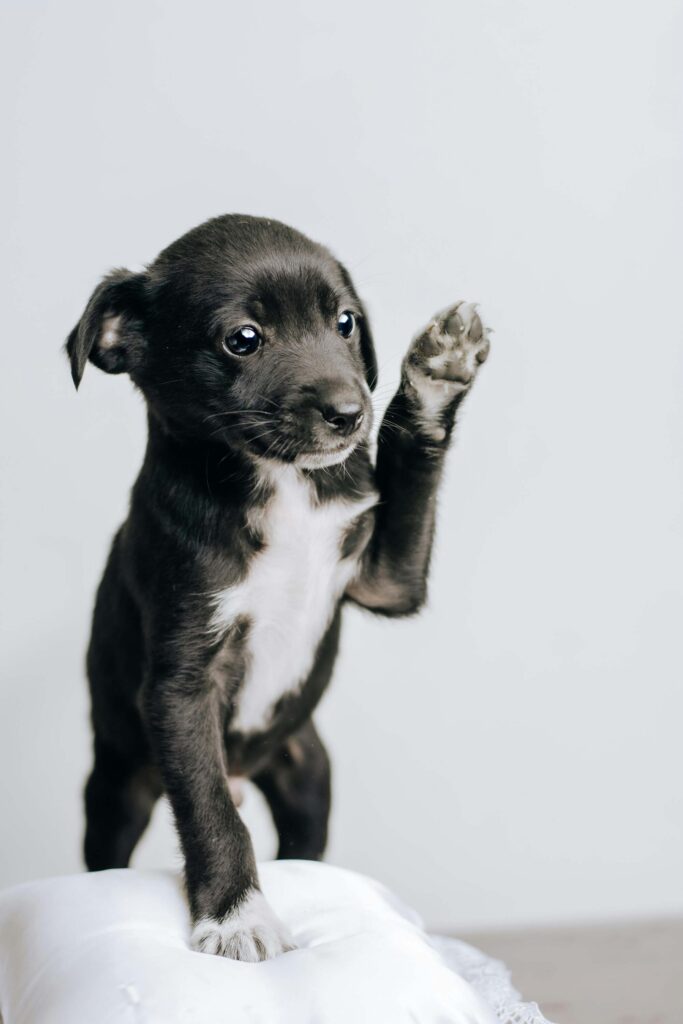
Each of these should be a calm introduction followed by a treat and praise when your puppy approaches a new person, sound, or sight with curiosity but without fear or anxiety. If your puppy seems frightened, back off and try again later. The goal is to show them that the world is safe. Once your puppy is fully vaccinated, which is usually around 9-12 weeks, start socializing them with other dogs. This could be through a puppy kindergarten class or through playdates friendly adult dogs. All of this is non-negotiable for raising a well-adjusted, non-reactive dog. The research is clear: properly socialized puppies “are less likely to exhibit behavioral problems as adults, including aggression and fearfulness”
Bite Inhibition
You should already have started curbing those nips and need to continue discouraging this behavior throughout your puppy’s teething phase. Don’t let biting slide because you think “puppies will be puppies.” If you yelp on a really hard bite, your puppy learns not to use those needle teeth on you. If play gets too intense, calmly end it.
Redirect gnawing to chew toys. A good trick: carry a chew toy in your hand during play. If the puppy goes for your hand, immediately hand them the toy instead. Reward them for chewing it. Bite inhibition can take weeks, but start now so they never learn that biting hands is okay.
New Puppy Owner Tips: Common Mistakes to Avoid
Even the most seasoned pet parents can slip up sometimes. If this is your first time bringing home a puppy or you’re handling one after a long time, expect there to be mistakes along the way. While minor slip-ups are par for the course, any serious mistakes can have lifelong consequences for your puppy as well as your relationship with them. Keep these tips for bringing home a new puppy and raising them right in mind to steer clear of some of the most common yet costly dog parenting mistakes:
1. Punishing Your Puppy
Sounds obvious, but it’s easy to feel enraged when your little furball steals a sausage or pees on the rug. However, experts universally say that punishment backfires. VCA behaviorists warn that things like scruff shaking or yelling “do not mimic how dogs communicate and such handling can lead to fear, anxiety and even retaliation.”
You focus on teaching the dog what you want, rather than disciplining what you don’t want. For example, if your puppy chews a shoe, say “uh-uh” calmly, redirect to a chew toy, and praise when they take it. If they go potty inside, clean it without scolding, and keep taking them outside consistently. Never hit or shake a puppy. It just breaks trust and can create behavioral issues later.
Suggested Reading: How To Train A Dog To Listen: 8 Steps
2. Puppy-Proofing Slip-Ups
Watch your home constantly as the weeks go by. What’s safe at 8 weeks might be chewed by 12 weeks. Never assume “that pile of laundry is fine on the floor.” Puppies are endlessly curious. They will nibble houseplants, dig in trash bags, chew electrical cords, or even try to eat fallen food from under the table.
Make it hard for them. Use gates, keep things out of reach, and recycle hazards. A great trick is to spend a day on “supervised puppy patrol” where you follow the pup room-to-room. You’ll be amazed what dangerous things you discover at dog level.
3. Overfeeding
It’s very easy to overfeed a puppy, especially with treats. But a pudgy puppy is unhealthy and likely to grow into an overweight dog that is more likely to suffer from joint issues and other medical conditions. Puppies should be lean and active. A good rule of thumb to gauge whether your pet fits that bill is this: you should see a little waist and easily feel, but not see, their ribs.
So, measure portions, limit treats to no more than 10% of daily calories, DO NOT feed your puppy table scraps, and never give into those puppy eyes guilting you into overfeeding.
4. Inconsistency in Rules
Make one rule chart for everyone and stick to it. If Dad lets the puppy on the sofa but Mom scolds him, they’ll end up confused. Whether it’s “crate time means quiet time,” “the dog sleeps on his own bed,” or “no begging at the table,” consistency is key. Mixed messages delay learning. If one family member is the “fun one” and lets every behavior slide, you’ll have on your hands a very spoiled pup.
5. Skipping Early Training
Many think “they’re too young to learn,” but dog trainers emphasize, “It is best to begin training a puppy as soon as you bring him into your home.” Even tiny puppies can learn bite inhibition, name recognition, and basic manners. If you delay training until they’re older, you lose precious time. Early training also establishes you as the leader who sets boundaries.
Suggested Reading: How to Train a Dog Off Leash
6. Neglecting Socialization
Waiting too long to introduce the world is a big mistake. Remember, the socialization window is brief, and if you miss it, you risk ending up with a dog that is fearful or aggressive, or both. Exposing your puppy to new experiences safely now is what prevents phobias later. That means, under vet advice, letting them meet vaccinated, friendly dogs, and introducing them to car rides, crowds, gentle noises, gradually before they hit the 16-week mark.
7. Excessive Exercise
This one can surprise new owners. Too much running or jumping can harm a growing puppy’s joints. Short play sessions are great, but skip the long jogs, especially for large-breed pups. Until their growth plates close, which is often around 1-year-old for large breeds, stick to gentle play, short walks on soft surfaces, and lots of rest.
8. Lack of Veterinary Care
Finally, don’t procrastinate on vet visits or preventive care. Missing vaccines or delaying spay/neuter can have serious consequences. Keep your vet’s number handy for questions. Emergencies do happen, often after hours. Know your local emergency clinic. Being prepared can save your puppy’s life and your peace of mind.
New Puppy Checklist
Here is a quick recap of everything you need to know and remember when bringing a puppy home and beginning your pet parenting journey. Use this checklist as a guide through those early puppy days. Download and save it on your phone or print and put it up on the refrigerator so you can tick off each task, at every step of the way. Soon you’ll be on your way to raising a happy, healthy dog.
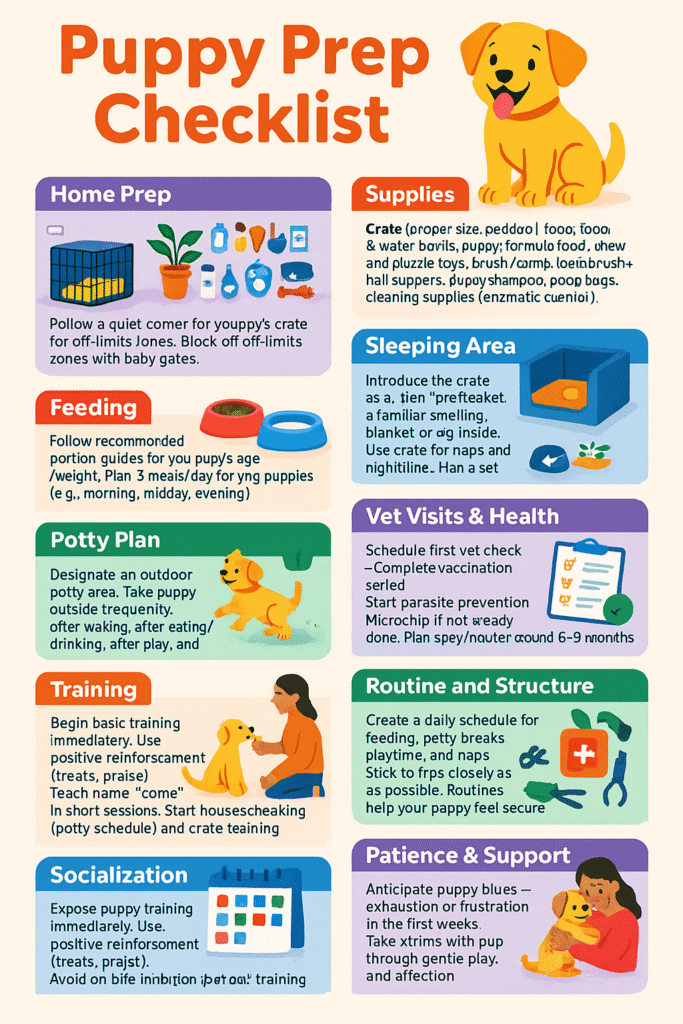
Final Thoughts
Welcoming a puppy is a huge, wonderful commitment. Trust your instincts but also lean on experience—both yours and that of experts. Ask questions, read trusted sources, and remember that the early challenges are building a foundation for years of love and companionship. With patience, consistency, and a lot of treats, you’ll watch your little ball of fur grow into a happy, well-mannered dog that enriches your life every day.

